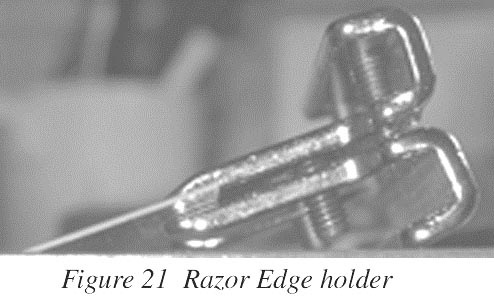Results 1 to 10 of 64
Thread: Verhoeven Paper Question
Threaded View
-
03-04-2009, 09:39 AM #20Coticule researcher

- Join Date
- Jan 2008
- Location
- Belgium
- Posts
- 1,872
Thanked: 1212
All sources I ever read, including your link, always advice to dress the leather with an abrasive compound.
But strictly spoken, everything on this planet has some abrasive qualities even a cucumber sliced lengthwise in half. Entire mountains are reshaped by mere rainfall. The big question is, have we the patience and time to wait for it?
Verhoeven conducted the leather experiments on flat hones and flat leather strops, using this jig, leaving the specimen blades attached in the jig during the entire honing and stropping progression:

(picture taken from page 18 with reference to the original article at http://mse.iastate.edu/fileadmin/www...nifeShExps.pdf)
He checked his results at 3000X magnification, using an Scanning Electron Microscope, and found no discernible diminishing of 6000 grit abrasive grooves.
That is as scientifically bulletproof as it gets. Verhoeven had to change his mind about leather: "(...), it was initially thought that a clean strop would contain enough natural abrasive material to produce a marked improvement in the quality of the edge. As a result, several initial experiments were done with clean leather strops,including an experiment with alternate 3 cycles of 4 leather stropping plus a single 6000grit sharpening. In all cases the clean leather stropping proved ineffective in comparison with the dramatic improvement found with the chrome oxide loaded strop." (page 22 of same document)
For what it's worth, in my opinion, that closes the case. If stropping has an affect on an edge (and I agree it does), it clearly is not the result of any significant abrasion. The most likely explanation that remains, is proper alignment of the extremely narrow strip of erratic steel at the very tip of the edge. I advocate the use of the word "fin" for that strip. Stropping on clean leather is friction and it aligns and straightens out the fin of an edge. Stropping on paste is an entirely different thing.
Bart.
-


 2Likes
2Likes LinkBack URL
LinkBack URL About LinkBacks
About LinkBacks







 Reply With Quote
Reply With Quote